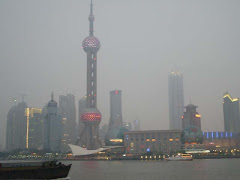
Even after returning home from our year in Beijing I still frequently reflect on my extended visits to this city (1985, 1996, and 2006) over the last twenty years. It’s very hard to match any vision of “old Beijing” with the new. Twenty years ago Beijing’s crowded shopping districts were seas of blue and green uniforms; with unusual flares of neon pink t-shirts revealed on warmer days. Today nearly everyone is dressed in whatever the West is wearing, and often with even more style. Traffic ten years ago still chimed to the sound of many bicycles attenuated with the buzz of taxis and “bread loaf” mini-buses and the rumbles of accordion-like extenuated buses and heavy trucks. Today it’s a constant thunder of cars, trucks and busses everywhere the traffic is not frozen in gridlock on the broad avenues and ring roads throughout the city. Twenty years ago I felt like a novelty as a foreigner, although Beijing seemed accustomed to spotting the occasional Eastern Bloc visitor. Ten years ago, the novelty had worn off. Last year I rarely received a second glance, although now it seems that foreigners with the most money get the most attention.
Last year in Beijing my morning walks with my oldest daughter to the public elementary school she attended revealed each day the many rapid changes that Beijing is undergoing. We first walked through the front gate of our apartment complex into the crush of garment-laden pedicabs, taxis and bicycles swarming around the “Alien Street” market, a favorite shopping destination for Russian, Eastern European and Central Asian tourists, who buy black garbage bags stuff of merchandise for resale back home. Beyond the market three large construction sites have been humming all night long, and we could see the night crew of laborers from China’s hinterland leaving their posts only to be replaced by the day crew.
Walking past the construction sites we entered a short stretch of old Beijing. This is one of the embassy compounds on the “old “Eastern Bloc” side of town. We passed the high walls of the DPRK (or North Korean) embassy compound, which always seemed very quiet and somewhat mysterious. The tall leafy sycamores still line the streets, and residents enjoy leisurely walks to and from the nearby Ritan (Temple of the Sun) Park, where many go for early morning Taiqi or calisthenics.
Increasingly, however, younger Beijingers with means are fleeing such old neighborhoods for the material comforts of upscale housing complexes such as the one in which we lived or to more landscaped compounds beyond the third and fourth ring roads. Twenty years ago everyone I knew was concerned with economic improvement but was uncertain how to proceed, given that the central government had only recently been permitted such self-enrichment. Now, with economic prosperity not only permitted but almost mandated in the constitution, people are far more concerned about its cost, personal and environmental. Even ten years ago the late autumn sky was often blue with only the yellowish tint of charcoal haze produced by the millions of briquette-burning stoves throughout the city. Today a bluish-white cloud of exhaust often settles on downtown Beijing until a good breeze clears the air to reveal the distant new, suburban high-rises and the mountains beyond.

